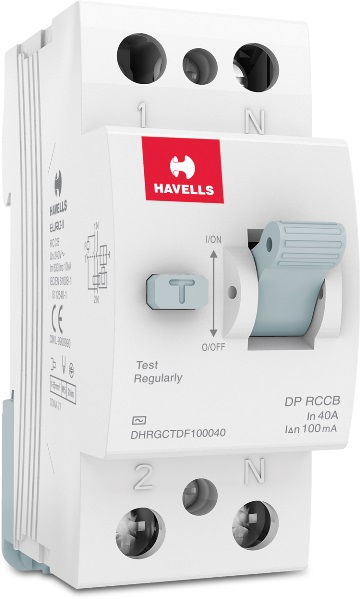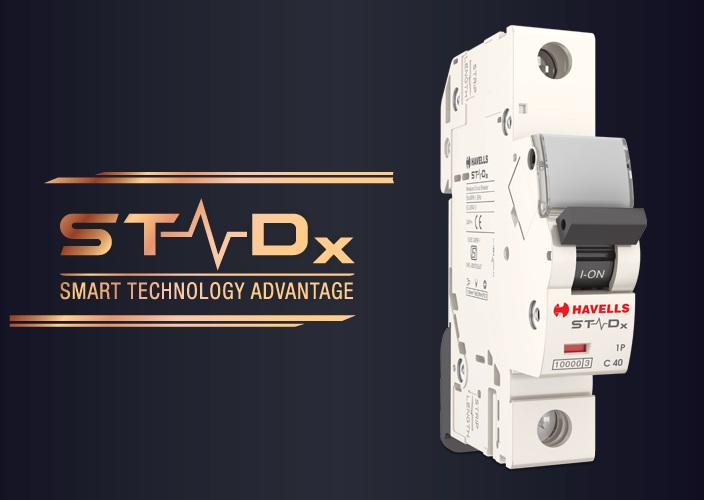
Recently, Tamil Nadu Electricity Regulatory Commission (TNERC) made it mandatory for electrical installations to be equipped with residual current circuit breakers (RCCB) with a view to eliminating risk of fire and electric shock. In this backdrop, T&D India caught up with Havells India, a leading supplier of RCCBs and other protection switchgear, to understand the technical and practical aspects of RCCBs. In this exchange, Saurabh Goel, President, Havells India, gives a comprehensive understanding of RCCBs from the consumer’s perspective. Goel feels that though RCCBs are currently overlooked by majority of consumers, proactive steps from regulatory authorities, discoms and manufacturers like Havells India, will see RCCBs receiving their due attention in good time.
Let us start by understanding what “residual current” means. What are its causes and what could be the detrimental impact of residual current in an electric circuit?
In principle, the current flowing to the circuit from the live wire should be the same as that flowing through the neutral wire. In case of a fault, the current from the neutral wire gets reduced, the differential between the two is known as residual current. The term is well defined by the name RESIDUE Current, which is “remainder” current. The use of exposed, substandard, badly wired, wrongly connected or damaged equipment as well as frayed or badly repaired cables reduces the safety of an installation and increases the risk of person receiving an electric shock due to leakage current.
Avoiding the importance of an RCCB (residual current circuit breaker) can lead to an injury. While strong currents may cause some degree of discomfort or pain, more intense currents may induce involuntary muscle contractions, preventing the victim from breaking free of the source of electricity.
“An RCCB is an important safety measure when it comes to protection of electrical circuits.”
How does an RCCB work and how does it help dealing with residual current?
The RCCB works on the current balance principle. The supply conductors —the phases and the neutral — are passed through a toroid and form the primary windings of a current transformer. Its secondary winding is connected to a highly sensitive electromagnetic trip relay, which operates the trip mechanism.
An RCCB is an important safety measure when it comes to protection of electrical circuits. It is considered as a current-sensing device, which can automatically measure and disconnect the circuit whenever a fault occurs in the connected circuit, or the current exceeds the rated sensitivity.
An RCCB is a life-saving device, which detects any current leakage in circuit and disconnects the circuit immediately well before that leakage can cause a life-threatening shock. It becomes all the more important for devices installed in washroom, kitchen and laundry rooms as water and electricity don’t mix well.
Do the terms RCCB and RCD refer to the same device?
Yes, Residual Current Device (RCD) is also known as Residual Current Breaker (RCB) or Residual Current Circuit Breaker (RCCB).
RCD is the term that covers a family of devices. RCCBs are RCDs without any overload protection. RCBOs are RCDs with over-current protection included in the device. CBRS are circuit breakers with residual current protection which may or may not be integral. SRCDS are socket outlets with RCD protection.
“Despite being one device that prevents shocks and saves precious human lives, nearly 90 percent of homes do not have RCCBs or ELCBs.”
Is there enough awareness among consumers (especially residential and commercial) to have RCCBs installed, alongside conventional MCBs?
 One of the most overlooked devices in household is an RCCB or ELCB, which is a crucial device that breaks the circuit in fraction of second within moments of sensing leakage current, thereby preventing electrical shocks.
One of the most overlooked devices in household is an RCCB or ELCB, which is a crucial device that breaks the circuit in fraction of second within moments of sensing leakage current, thereby preventing electrical shocks.
Despite being one device that prevents shocks and saves precious human lives, nearly 90 percent of homes do not have one. Many state governments or discoms on their part have taken the right steps to make RCCB or ELCB compulsory. Despite that, installing an RCCB is followed more as an exception than a rule.
Monsoon is as good a time as any to check whether our house has this vital life-saving device or not. One should also check for a good electrical earthing pit, which is essential for functioning of a good electrical network of the house.
Electrical majors with focus towards human safety have started to give these devices (also called PRCD), pre-fitted in geysers and washing machines – two appliances which have an interplay of water and electrical current, which may lead to electrical shocks.
Havells is the first one in the industry to launch PRCD devices; an innovative adaptor type RCCB we call as PRCD plug and adaptor. These can be installed with devices where we have higher possibility of human interaction with machine (leakage current threat) like washing machine, water cooler, desert coolers, microwaves, water purifier, laptops, music speakers, Geysers, hair dryers etc.
Also read: Havells Launches Anti-Viral Range Of Switches
Recently, Tamil Nadu Electricity Regulatory Commission (TNERC) issued an order making installation of RCCB/RCD mandatory. Do you think such a move is worth emulating by other states?
Yes, we believe the decision by TNERC in making the installation of a residual current device (RCD) compulsory in all electricity service connections will ensure prevention from electrical accidents and loss of human lives.
To provide our family with a safer home, it is necessary to equip our homes with devices that act as a safety shield in order to protect us from electrical hazards. There is this basic principal of electricity supply, what goes in, must go out. This means the amount of electricity coming to your home must be equal when going out. If there’s any difference in both, that means somewhere at your home, electric current leakage is going on. Any faulty appliance or any socket which doesn’t have proper earthing is leaking current somewhere which could lead to unexpected damages to the people living at home and an MCB (miniature circuit breaker) cannot save you from that as it is unable to detect low-level leakage.
Havells India always been a thought leader in espousing the cause of electrical safety and we have taken various steps to reinforce the need for the same.
Havells is a leading supplier of RCCBs. Please tell us about technological improvements that have made RCCBs more effective, over the years?
 Havells’ switchgear portfolio offers a complete range for circuit protection for the rapidly urbanizing Indian market. The switchgear market is evolving due to the integration of industrialization and “informatization”, development of smart-grids and smart cities.
Havells’ switchgear portfolio offers a complete range for circuit protection for the rapidly urbanizing Indian market. The switchgear market is evolving due to the integration of industrialization and “informatization”, development of smart-grids and smart cities.
Addressing the need, Havells being one of the pioneers in the switchgear segment, had introduced ST^Dx range of RCCB’s that is a communication-ready range. This range provides a user-friendly one-touch interface to building’s myriad electrical load layout.
With multifunctional capabilities including remote switching, the advanced version of Havells ST^DX offers real time monitoring status and facilitate pro-active maintenance of the device. The entire range will improve uptime making modern businesses more competitive and limiting intervention cost. With advanced programming of load cycle and efficient energy management, the range is aiming to minimize energy wastage and improve sustainability. Designed to meet the modern needs, the advanced range ensures safety with flag indication, mid trip feature and user friendly assembly and operation.
“To reiterate the messaging around consumer safety, we recently launched our campaign #ShockKaVaccination, in a bid to promote electrical safety through the RCCB product range,”
How is Havells promoting the deployment of RCCBs to electrical contractors, and to consumers at large?
 Havells India always been a thought leader in espousing the cause of electrical safety and we have taken various steps to reinforce the need for the same. We have constantly provided training to electricians in order to promote electrical safety. We have also signed several MoUs with discoms, widespread consumer interaction through RWA/IWA(s) etc., where our technical personnel explain the advantages of using right quality protective equipment, for the safety of both –equipment and precious lives.
Havells India always been a thought leader in espousing the cause of electrical safety and we have taken various steps to reinforce the need for the same. We have constantly provided training to electricians in order to promote electrical safety. We have also signed several MoUs with discoms, widespread consumer interaction through RWA/IWA(s) etc., where our technical personnel explain the advantages of using right quality protective equipment, for the safety of both –equipment and precious lives.
Keeping in mind the safety of Indian consumers, Havells India and Tata Power Delhi Distribution Ltd (Tata Power DDL) signed an MoU to strengthen the distribution of RCCBs in north and north-western regions of Delhi. In addition, we have same understanding with BSES Rajdhani. The association helps us sensitize consumers on the need to incorporate best in class protection devices in their homes and together we ensured that consumers are aware of the use of ELCB/RCCB through Tatat Power-DDL customer care centres.
To reiterate the messaging around consumer safety, we recently launched our campaign #ShockKaVaccination, in a bid to promote electrical safety through the RCCB product range, urging consumers to install circuit protection devices to protect themselves and their family from electrical shocks. The digital film visually emphasizes on the risk of an electric shock in the absence of RCCB a very simple yet vital device which should be a part of every home.
“In the near future, we shall be adding technologically advanced electronic protection switchgear and downstream protection devices,”
Do you see an uptick in sales of RCCBs in recent years?
 In recent times, customer experience has realized the importance of using an RCCB at their homes. The present crisis has also increased the consciousness of the people on safety issues in general, this too has increased demand for safety gadgets like MCB and RCCBs amongst the general populace.
In recent times, customer experience has realized the importance of using an RCCB at their homes. The present crisis has also increased the consciousness of the people on safety issues in general, this too has increased demand for safety gadgets like MCB and RCCBs amongst the general populace.
Though the real estate sector has been generally underperforming over the last couple of years, however uptick in residential and commercial construction and ongoing electrification programmes of the government would support growth of switchgear market
Havells India leads in this sphere with deeply penetrated channel strength. Due to electrification reaching near 100 per cent in the country, and given the fact that the prevalence of conventional fuses is to the tune of nearly 40 per cent even now, we are confident of the ever-increasing need for quality switchgear in the country in the foreseeable future.
In the near future, we shall be adding technologically advanced electronic protection switchgear and downstream protection devices, which will address much needed void in the segment.
In addition, we will consolidate our wiring accessories and automation range, expanding the offer for masses.


